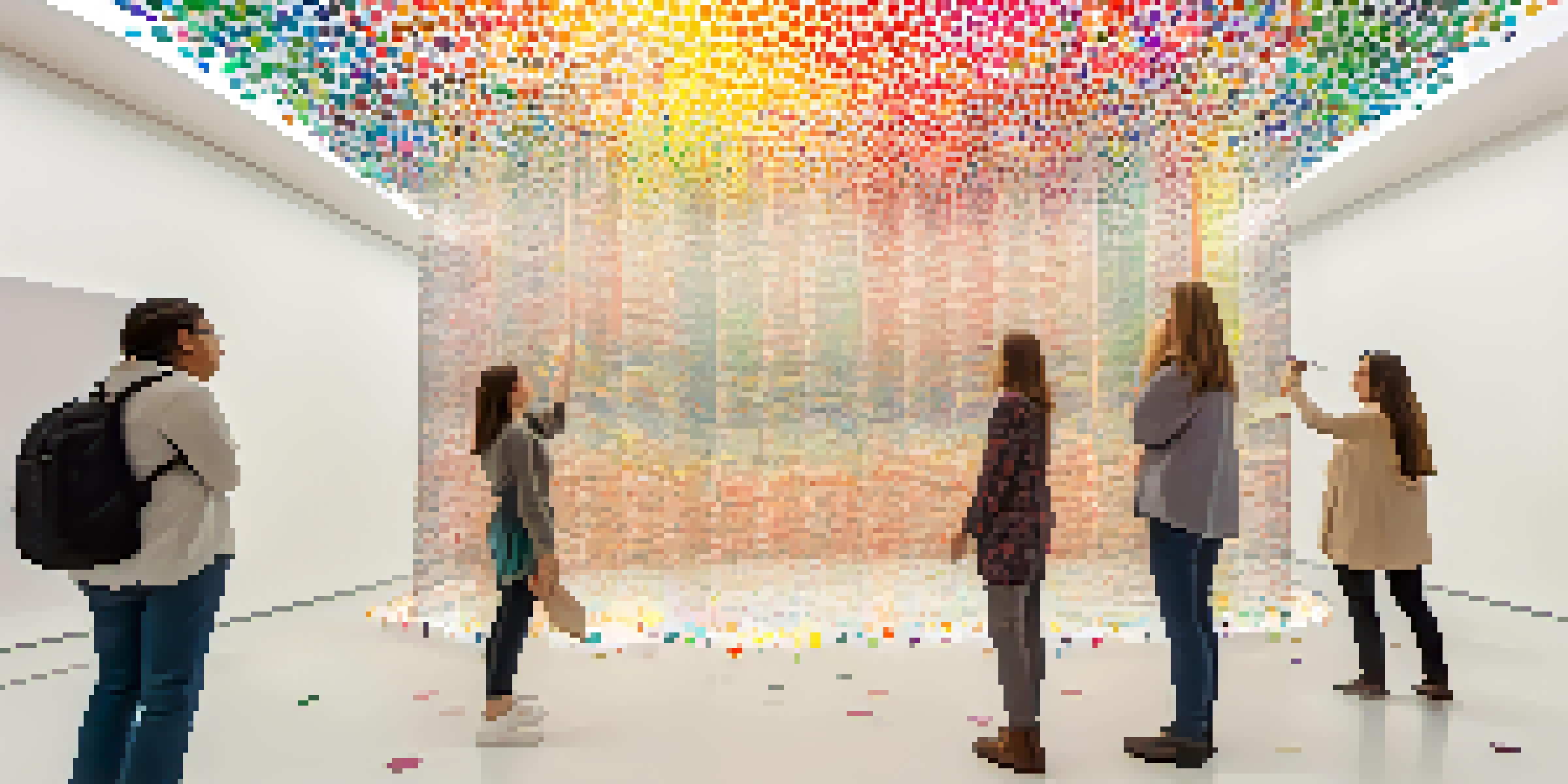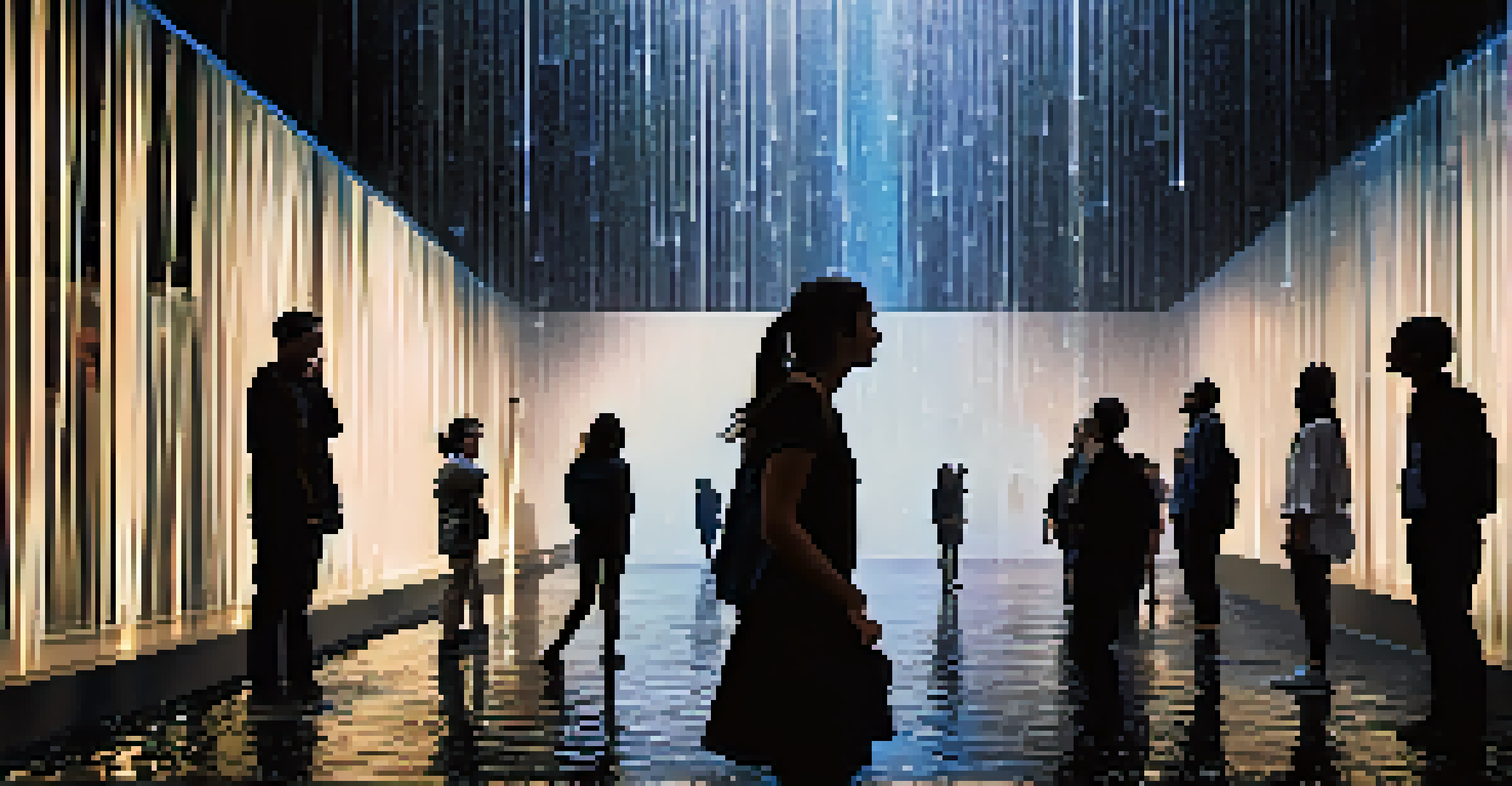Interactive Art: Engaging Audiences Through Technology

Understanding Interactive Art and Its Evolution
Interactive art is a dynamic form of expression that invites viewers to engage with the artwork. Unlike traditional art, where the audience is merely a spectator, interactive art encourages participation, making the experience more personal and immersive. This evolution demonstrates how technology has transformed the art landscape, merging creativity with innovation.
Art is not a thing, it is a way.
Historically, art was often confined to galleries and museums, but as technology advanced, artists began to explore new mediums. The introduction of digital platforms, augmented reality, and virtual reality has allowed artists to break barriers and reach wider audiences. Today, interactive art can be experienced not just in physical spaces but also through screens and devices, making it accessible anywhere.
This shift has created new opportunities for artists to connect with their audience on a deeper level. By allowing viewers to influence the artwork through their actions, artists can spark conversations and provoke thought, turning passive observation into active participation. This engagement is essential for fostering a community around the artwork.
The Role of Technology in Interactive Art
Technology serves as the backbone of interactive art, enabling creators to push boundaries and redefine how art is experienced. Tools like sensors, projectors, and mobile applications allow artists to create experiences that respond to audience interaction. This integration of technology transforms static art into dynamic experiences that can evolve over time.

For example, installations that use motion sensors can change visuals or sounds based on the viewer's movements. This not only captivates the audience but also creates a sense of ownership over the experience. The audience becomes part of the artwork, contributing to its narrative and outcome, which can lead to a more profound connection.
Interactive Art Enhances Engagement
By inviting audience participation, interactive art transforms passive observation into immersive experiences that foster deeper connections.
Moreover, technology also facilitates collaboration between artists and audiences. Many interactive art projects invite participants to contribute their ideas or even create content themselves. This collaborative spirit not only enriches the artwork but also fosters a sense of community among participants, enhancing the overall experience.
Examples of Interactive Art Installations
One of the most famous examples of interactive art is the 'Rain Room' installation by Random International. This immersive experience allows visitors to walk through a room of falling water without getting wet, as sensors detect their movements and stop the rain above them. Such installations not only showcase technological prowess but also highlight the magic of interaction.
The best artist has no conception that a marble block does not contain within itself, but rather, he sees the potential to create something beautiful through interaction.
Another noteworthy example is the 'The Obliteration Room' by Yayoi Kusama, where visitors are given colorful dot stickers to place in a completely white room. Over time, as attendees contribute their stickers, the space transforms into a vibrant explosion of color, creating a unique artwork that evolves with each visitor's input. This exemplifies how interactive art can be a collective experience.
These installations demonstrate that interactive art can evoke emotions, provoke thoughts, and invite audiences to reflect on their role in the artistic process. By participating, visitors become co-creators, adding layers of meaning that might not have existed otherwise, making each experience unique.
The Impact of Interactive Art on Audience Engagement
Interactive art has a profound impact on audience engagement, significantly enhancing the way people experience art. By allowing viewers to actively participate, these artworks foster a sense of connection and investment in the experience. This leading engagement transforms the art from a simple visual display into a memorable adventure.
Research shows that when audiences engage with art interactively, their emotional responses and retention of the experience increase. This heightened engagement can lead to a more meaningful appreciation of the art form itself. People often leave feeling inspired, having developed a personal connection to both the artwork and the artist.
Technology Fuels Artistic Innovation
The integration of tools like sensors and apps allows artists to create dynamic artworks that respond to viewer interactions.
Moreover, interactive art can bridge generational gaps, attracting diverse audiences who might not typically engage with traditional art. Families, children, and technology enthusiasts find joy in these immersive experiences, creating a more inclusive environment that encourages exploration and curiosity.
Challenges Faced by Interactive Artists
While interactive art offers exciting possibilities, it also presents unique challenges for artists. One significant hurdle is the rapid pace of technological advancements, which can make it difficult for artists to keep up with the latest tools and trends. This constant evolution can lead to pressure to innovate while also balancing artistic integrity.
Additionally, creating interactive art can be resource-intensive, requiring not only technical skills but also a understanding of audience psychology. Artists must carefully consider how to design experiences that are intuitive and engaging, ensuring that viewers understand how to interact with the artwork without feeling lost or overwhelmed.
Lastly, there’s the challenge of accessibility. While technology can enhance the experience, not all audiences may have equal access to it. Artists must strive to create inclusive works that can be appreciated by everyone, regardless of their technological familiarity or physical abilities.
The Future of Interactive Art
The future of interactive art is brimming with potential, particularly as technology continues to evolve. With advancements in artificial intelligence, augmented reality, and even virtual environments, artists have more tools than ever to create innovative experiences. This opens up exciting avenues for storytelling and engagement that were previously unimaginable.
As interactive art gains popularity, we may see more collaborations between artists and technologists, leading to the development of entirely new art forms. These partnerships can enhance creativity and push the limits of what is possible, resulting in experiences that challenge our perceptions and encourage exploration.
Challenges in Creating Interactive Art
Artists face hurdles such as keeping up with technology, ensuring intuitive design, and making their work accessible to diverse audiences.
Moreover, as society becomes increasingly digital, interactive art has the potential to thrive in online platforms, reaching wider audiences across the globe. This accessibility can democratize art, inviting more people to participate, share, and engage with unique artistic expressions.
Conclusion: The Power of Interaction in Art
In conclusion, interactive art represents a transformative shift in how we engage with creativity. By integrating technology, artists invite audiences to step beyond passive observation and into active participation. This engagement not only enriches the art experience but also fosters community and connection.
As we look to the future, the possibilities for interactive art are endless. The combination of artistic expression and technology can create immersive environments that captivate the imagination and inspire a new generation of creators and viewers alike. The art world is evolving, and interactive art is at the forefront of this exciting journey.

Ultimately, interactive art reminds us of the power of human connection and the importance of participation in the creative process. It challenges us to rethink our role as spectators and encourages us to embrace the beauty of collaboration in the world of art.